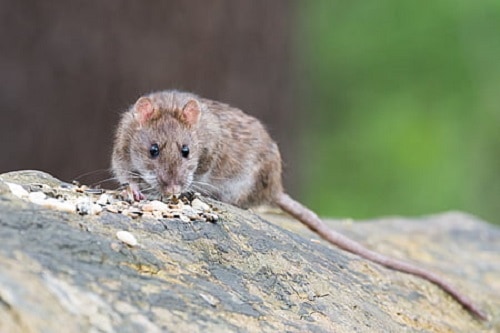- 5 Simple Tricks to Eliminate Maggots From Pet Waste - October 24, 2023
- Keep Your Outdoor Compost Piles Maggot-Free - October 24, 2023
- How to Get Rid of Maggots – Methods that Work - August 30, 2023
The other morning you heard a scatter outside your window in the three. You went over to the windowpane, amazed to find a rat looking at you and thinking to yourself since when do rats reside in trees.
The problem was there were quite a few rats in the tree. Just the thought leaves you amazed yet paralyzed. So how do you get rid of roof rats living in a tree? Why are they making your tree their home? Furthermore, how do you prevent access inside the attic?
To find out how to take care of rodents making the trees in your yard their homes, you need to know a bit more about the rat and its habitat.
Basics Of The Roof Rats
The Rattus-Rattus goes by many names from roof rats, ship rats, house rats, and more. You find roof rats in big numbers around the world.
Over the years, these rats have traveled by sea and getting off at points to mate with other rats. Therefore, in the days of old, you found roof rats in homes on the coast.
However, over the years this has changed and there are no rights reserved for roof rats as they are found inland as well.
So how do you know you have a roof rat in the tree? The rodent has a deep brown or black appearance with large ears with a little fur.
The animal is nocturnal and enjoys making attics or the roof part of their homes, and they have an omnivorous diet enjoying from fruit, vegetables, grains, pet food, to insects.
The Roof Rats Natural Habitat
You can find these roof rats living in different areas, and the place they thrive the most is in your attics or roof. While the roof rat lives in coastal areas, they do not enjoy swimming but very skilled at climbing.
Furthermore, their lengthy tails help them to climb and balance, making it easy to climb that tree standing outside your bedroom window.
Moreover, the rat is not meticulous where to stay, and they reproduce throughout the year, and breeding rises from February to March and from May to June.
Are Roof Rats the Only Rat That Resides in Trees?
Now, as you are standing watching those trees are you sure it is roof rats, or is it Norway rats. The Norway rats may live in burrows in your garden but use the tree to get access to the building or birds’ nests.
While Norway rats have coarse brown hair and large size, it has small ears and eyes. On the other hand, the rat’s tails have no fur and look scaly. Conversely, the Norway rat may remain outside in the garden, but it can access homes for food.
Alternatively, it is the roof rat that enjoys making attics their nest compared to the Norway rat. Why it enjoys gravitating to high places like trees? Therefore if you are wondering if the rat sleeps in trees, yes, they do. A fact is that most of their nesting takes place in trees.
For accessing the tree, the roof rat can move over power lines and maneuver up walls. Furthermore, the roof rats are nifty leapers and do this both vertically and horizontally.
When roof rats start to build a nest, they make use of sticks, foliage, and their favorite nesting spot is the Palm tree. However, trees are not the only place roof rats nest and they also love to make your homes their abode.
You can find roof rats in lush plants and woodpiles outdoors as well.

So why is it a concern to see roof rats in trees?
The problem is not that the roof rat resides in trees, but they multiply at a fast rate and can move into your attics causing a rat infestation. For socializing these rodents, stand at the top with multiple males and females.
Furthermore, you may find one dominant male with a hierarchy of females as well. On the other hand, the females are more aggressive than males.
To add to the problem, they are polygynous and bread all year round. With the results, they can produce up to five litters in a year now you can imagine what can happen if they decide to move into your house.
Wow, that figure is astounding, and we are confident you do not want a population of rats living in or around the home. Now imagine one male producing a litter with each female in the social group.
The rodent lives for about a year when in the wild. However, in captivity, the rat can live up to four years. Moreover, the rodent lives nearby food sources like pet pellets, trashcans, the pantry, kitchen, and more.
Furthermore, when living in the house, the main predator is a cat, while in less populated areas, the biggest threat is birds and carnivorous animals like snakes. While many people use the Norway rat for research and some, keep them on as pets, the rodent remains dangerous for humans.
The rat has a destructive behavior on farms, crops, and fruit trees. Furthermore, they urinate and defecate on foodstuff remains left behind and spread diseases. The fleas that live on the pest also carry seriously harming illnesses for humans and livestock as well.
How to Get Rid of Rats in Trees to Prevent Infestation
The best approach is to work with a pest management service to get rid of rats in trees. You need to do this before these rodents become an infestation, causing structure damage, transmitting parasites, or diseases. As they are nocturnal, they move around more at night. So how can you prevent this from happening? Here are some tips that can help remove this pest.
Trim trees and shrubs – by doing this, you remove branches that make contact with wires, fences, other twigs, and the rooftop. Make sure to cut the branches away at least three free from the ground. Remove the branches to expose the rats to predators.
Rat Guards – you can buy one or make one yourself. All you need is sheet metal of 24-inches full and the same length of the circumference of the tree plus two-inches. You attach the metal to the free, drill a hole, nail it two-inches from each corner, and wrap it around the trunk to prevent the rats from climbing. Now thread the metal wire through gaps to keep it secure.
Remove food attractions – try to remove all foodstuff attracting the rat. Make sure that garbage cans have secured lids. Place compost heaps in containers with lids, pick up your pet’s food after eating and never leave it standing overnight. Remove fallen fruit from trees and get rid of brush piles as well.
When you follow these steps, you can prevent the rat from getting access to your home as no one want to live with a house full of rodents. Alternatively, if none of the above helps we recommend you call in pest control services instead.
How do you know you have a roof rat in the home?
Now that you have seen a rat in the tree, you may be wondering if they have not already made your house their home. If you noticed droppings that are long and cylindrical around the home, the likeliness is that the rodent has come for a snack or has made the house their abode.
A fact is that both Norway rat and roof rats leave tracks behind that are about ¾ and one-inch. A mouse track is smaller, and they do not drag their tails like a rat leaving marks between the feet tracks. You will find gnawing holes of about two inches in diameter with rough edges.
The rat likes to chew on wood, and eventually, you may have damaged electrical wiring as well.
Conclusion
Therefore, if you see a rat in the tree next to your bedroom window, take action now. If you do not take action that rodents can become an infestation, you do not want in your home. We recommend you call a pest control service if any of the above tips do not help. They are qualified to take care of the problem for you to prevent these species from getting access to your living space.
Sources:
https://digitalcommons.unl.edu/cgi/viewcontent.cgi?article=1005&context=icwdmhandbook
https://journals.lww.com/joem/Citation/1960/07000/The_Acute_Toxicity_of_Pesticides_to_Rats.28.aspx
https://www.nytimes.com/2020/05/24/us/cdc-coronavirus-rats.html
